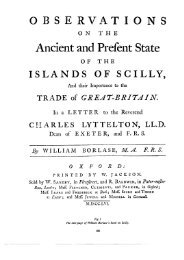Cornwall during the Iron Age and - Cornwall Archaeological Society
Cornwall during the Iron Age and - Cornwall Archaeological Society
Cornwall during the Iron Age and - Cornwall Archaeological Society
Create successful ePaper yourself
Turn your PDF publications into a flip-book with our unique Google optimized e-Paper software.
The question of Late Bronze <strong>Age</strong> <strong>and</strong> Earlier <strong>Iron</strong> <strong>Age</strong> settlement is still a county-wide<br />
problem. A trial excavation programme of hut circle settlements in sheltered or low-lying<br />
positions is indicated, but not in West Penwith where settlement, although geographically<br />
atypical, has received more than its share of attention so far. The new programme should<br />
concentrate on settlements with associated field systems <strong>and</strong> should be combined with<br />
detailed environmental studies backed up by radiocarbon dating. It is imperative that any<br />
excavation programme incorporates a full range of modern techniques, especially wet<br />
sieving, to retrieve evidence for agricultural practices. Fur<strong>the</strong>r environmental studies,<br />
following up <strong>the</strong> work at Colliford, are necessary finally to pull perceptions of Cornish tin<br />
out of <strong>the</strong> realms of semi-myth to firm reality. Programmes requiring specialised knowledge<br />
but comparatively few resources are needed for <strong>the</strong> ceramic material. The South-Western<br />
Decorated pottery sequence needs more detailed analysis to establish whe<strong>the</strong>r <strong>the</strong>re are<br />
detectable stylistic changes through time. Collections from Roman period sites should be<br />
examined to identify <strong>the</strong> full variety of non-Cornish products present. The range of future<br />
work offers something at every level, from <strong>the</strong> local field work so well done by <strong>the</strong> <strong>Society</strong>'s<br />
amateur members, through to major programmes of research excavation.<br />
Acknowledgements<br />
I owe a great debt in <strong>the</strong> preparation of this paper to Miss P.M. Canyon, both for making <strong>the</strong> Carvossa material<br />
available <strong>and</strong> for arguing points relating to <strong>the</strong> Roman period. I am grateful to Mr P. Donaldson for allowing me<br />
to examine <strong>the</strong> finds <strong>and</strong> records of Trevelgue. The preliminary draft of <strong>the</strong> article was read by Mrs P.M. Christie,<br />
Mr P. Ashbee, Lady (Aileen) Fox, Dr V. Maxfield, Miss A. Preston-Jones <strong>and</strong> Mr P. Rose <strong>and</strong> I have benefitted<br />
greatly from <strong>the</strong>ir comments. Figs 5 <strong>and</strong> 6 were drawn by Miss S. Morris <strong>and</strong> <strong>the</strong> various drafts typed by Mrs<br />
J. Hutchings. Finally, Figs 2-4 were drawn by my husb<strong>and</strong> Mr N.V. Quinnell; my thanks to him for <strong>the</strong>se, <strong>and</strong><br />
for general discussion <strong>and</strong> encouragement.<br />
Bibliography<br />
ApSimon, A.M. <strong>and</strong> Greenfield, E., 1972. 'The excavation of Bronze <strong>Age</strong> <strong>and</strong> <strong>Iron</strong> <strong>Age</strong> settlements at Trevisker,<br />
St Eval, <strong>Cornwall</strong>', Proc Prehist Soc 38, 302-381.<br />
Avery, M., 1972. Some Aspects of <strong>the</strong> <strong>Iron</strong> <strong>Age</strong> in South West Britain, Oxford University <strong>the</strong>sis.<br />
Avery, M., 1973. 'British La 'retie decorated pottery: an outline', Etudes Celtiques 13, 522 —551.<br />
Beagrie, N., 1983. 'The St Mawes ingot', Cornish Archaeol 22, 107-111.<br />
Beagrie, N., 1985. 'Some early tin ingots, ores <strong>and</strong> slags from Western Europe', J Hist Metal Stud 19-2,<br />
162-81.<br />
Bell, M., 1984. 'Environmental archaeology in South West Engl<strong>and</strong>' in H.C.M. Keeley (ed) Environmental<br />
Archaeology: A Regional Review, 42-54.<br />
Bidwell, P.T., 1979. The Legionary Bath-house <strong>and</strong> Basilica <strong>and</strong> Forum at Exeter, Exeter <strong>Archaeological</strong> Reports 1.<br />
Bidwell, P.T., 1980. Roman Exeter: Fortress <strong>and</strong> Town.<br />
Bidwell, P.T., forthcoming. Excavations of Roman Sites in Exeter 1971-80, Exeter Achaeological Reports 4.<br />
Brooks, R.T., 1974. 'The excavation of The Rumps cliff castle, St Minver, <strong>Cornwall</strong>', Cornish Archaeol 13,<br />
5-50.<br />
Carlyon, P.M., 1981. 'Some second century AD finds from Widemouth Bay', Cornish Archaeol 20, 224-6.<br />
Canyon, P.M., 1982. 'A Romano-British site at Kilhallon, Tywardreath: excavation in 1975', Cornish Archaeol<br />
21, 155 — 170.<br />
Christie, P.M., 1978. 'The excavation of an <strong>Iron</strong> <strong>Age</strong> souterrain <strong>and</strong> settlement at Cam Euny, Sancreed,<br />
<strong>Cornwall</strong>', Proc Prehist Soc 44, 309 — 434 .<br />
Christie, P.M., 1979. 'Cornish souterrains in <strong>the</strong> light of recent research', Bull Inst Archaeol Univ London 16,<br />
187-213.<br />
Clark, E., 1961. Cornish Fogous.<br />
Coles, J.M. (ed), 1981. Somerset Levels Papers 7.<br />
131




